15 Best Ways to Earn Free Crypto Without Getting Scammed
Scrolling through socials, you might have seen posts promising “instant Bitcoin” or “next-hour $SOL drops.” Sounds tempting, right? But the line between a legit promotion and a wallet-draining trap is razor thin.
Further, we will discuss the best ways to earn free crypto and show you how to avoid common problems and scams associated with that. Along the way, you’ll see why adding a VPN such as VeePN to your toolkit is just as important as setting up a strong wallet password.

Quick warning before the list of ways to get free crypto begins
Yes, there are legit ways to earn free cryptocurrency without making an upfront investment. From learning programs on your Coinbase account to free crypto airdrops during new token launches, you can collect crypto assets without dipping into your savings. You’ll know how in a bit.
But we need to place a warning here. The moment something is “free,” scammers are eager to swarm in. They build fake websites, copy the look of real platforms, and even create crypto apps that give free crypto, except those apps steal your wallet data. Some sneak in malicious browser extensions that spy on what you type. Others trick you into clicking shady pop-ups or signing bogus smart contracts. After the list of earning free crypto, you’ll also find the threats to be aware of and ways to protect yourself.
That said, let’s dive in.
The safest ways to earn free crypto
Here’s a solid list of beginner-friendly and low-risk methods that can help you get started in the crypto space, with all the key details, pros and cons.
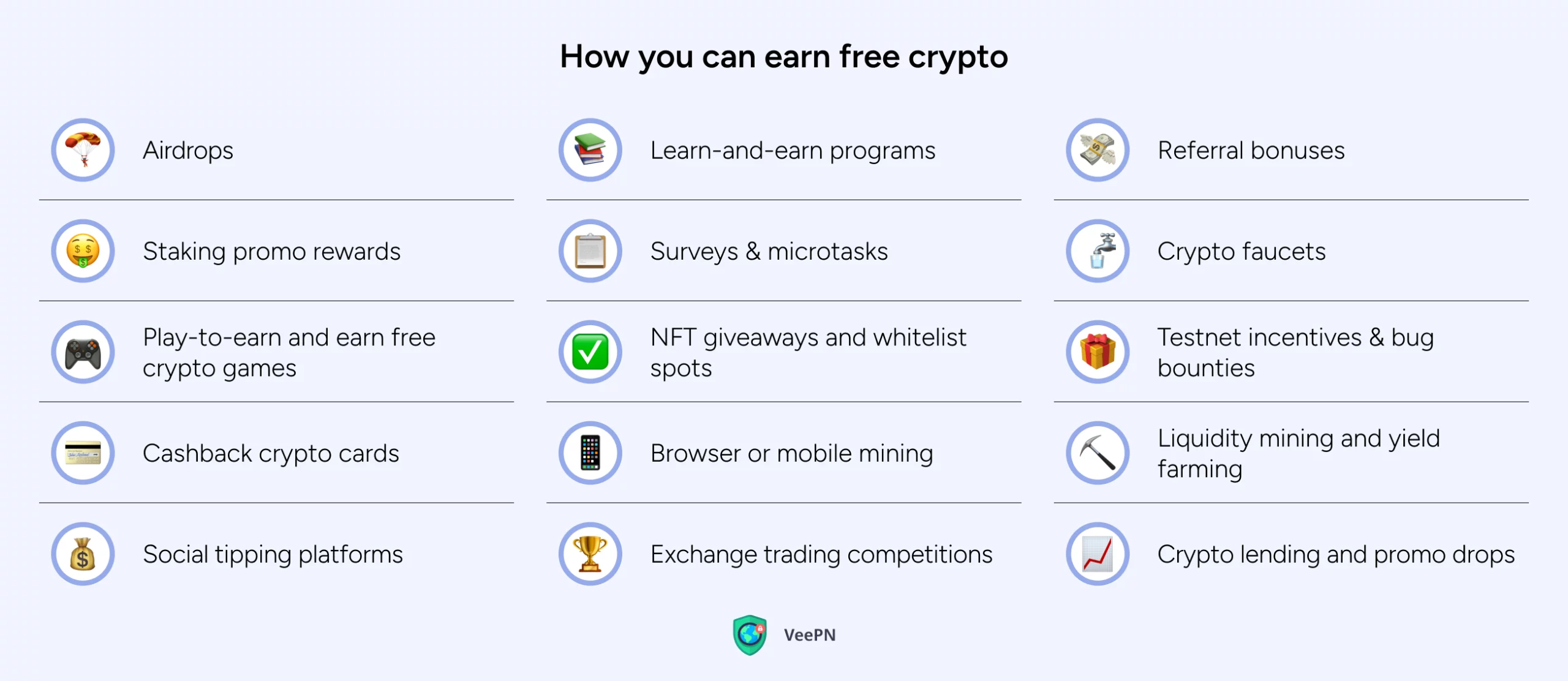
1. Airdrops
Airdrops are when crypto projects give away free crypto airdrops to promote new tokens.
How it works:
You usually need to join a community (like on Twitter or Discord), complete simple tasks (like following pages or signing up), or hold another crypto to qualify. Later, tokens are sent to your crypto wallet for free.
| Pros | Cons |
| 👍 No initial investment required. 👍 Easy to join with just a few clicks. | 👎 Lots of fake airdrop sites try to steal your private keys. 👎 Tokens may not be worth much at first. |
2. Learn-and-earn programs
Sites like Coinbase and Binance let you earn free cryptocurrency by watching short videos and answering quizzes.
How it works:
- You create a verified Coinbase/Binance account
- Go to their “Learn” section
- Complete short lessons
- Get rewarded in small amounts of crypto.
| Pros | Cons |
| 👍Great for beginners to learn while earning. 👍 Hosted on trusted crypto exchange platforms. | 👎 Requires KYC (ID verification). 👎 Lessons may not always be available. |
3. Referral bonuses
Many platforms offer free crypto rewards when you invite someone using your referral link.
How it works:
You share your unique referral link with friends. When they sign up and make a transaction, you both earn free crypto coins or discounts. To earn free crypto with this method, choose platforms with low trading fees and clear withdrawal rules. Always read the small print in terms and conditions.
| Pros | Cons |
| 👍 Passive earning method. 👍 Can stack rewards with minimal effort. | 👎 Some platforms make withdrawals difficult. 👎 Bonuses may depend on your friend’s spending. |
4. Staking promo rewards
Some platforms offer extra staking opportunities that let beginners earn rewards without locking up their crypto.
How it works:
You earn tokens by holding certain coins in your wallet or on a platform. Some give out extra promo rewards when you start. You can try soft staking options with no lock-up periods. This gives more flexibility if the crypto market shifts.
| Pros | Cons |
| 👍 A good way to generate passive income. 👍 Often works with stablecoins or popular assets. | 👎 You may need to wait days or weeks to unstake your assets. 👎 Price changes can reduce profits. |
5. Surveys & microtasks
Websites like Cointiply or TimeBucks let you earn small amounts of free Bitcoin and Altcoins for completing basic tasks.
How it works:
1. Sign up
2. Browse ads, complete surveys, watch videos, or download apps.
3. Get paid in Bitcoin or Altcoins.
| Pros | Cons |
| 👍 Easy tasks, no specific skills needed. 👍 Can earn in your spare time. | 👎 Very low payout. 👎 Some tasks may require personal info. Consider using a separate email for signups and enable a VPN like VeePN to protect your network security) |
6. Crypto faucets
A crypto faucet gives away tiny amounts of crypto (usually Bitcoin or Litecoin) for free, often in exchange for solving captchas.
How it works:
- Sign up on a crypto faucet site like FreeBitcoin or FaucetPay
- Connect your crypto wallet address
- Claim coins every time a timer resets (by proving you’re not a bot)
- The crypto is sent to your wallet or accumulated in your account for withdrawal.
| Pros | Cons |
| 👍 Simple and free to use. 👍 Helps you get comfortable with using a crypto wallet: copying wallet addresses, receiving funds, and checking balances. | 👎 Payouts are extremely small, usually a few satoshis per claim. 👎 Sites are often packed with ads and trackers. Avoid using your main wallet for safety. |
7. Play-to-earn and earn free crypto games
Some “earn free” crypto games allow you to collect tokens or NFTs simply by playing. These are built on blockchain and often reward your time, in-game achievements, or contributions.
How it works:
You sign up for a game like Gods Unchained, Alien Worlds, or The Sandbox. You may earn in-game currency or items that can be sold for real crypto. For example, winning a card battle or completing daily missions can earn you tradable tokens.
| Pros | Cons |
| 👍 Entertaining if you’re already into gaming. 👍 You can earn crypto rewards while leveling up or competing with others. | 👎 Some games require you to buy an NFT first to start playing. That’s why it’s better to stick to games with free entry options or demo modes 👎 Token prices can crash quickly, reducing your rewards’ value. |
8. NFT giveaways and whitelist spots
Many crypto projects like Cool Cats or Azuki and crypto creators offer limited NFT drops or whitelist spots as part of marketing campaigns.
How it works:
Follow different crypto projects and creators on Twitter/X, join Discord or Telegram groups, and complete tasks (like sharing posts or tagging friends). If selected, you may get a free NFT or a spot in a pre-sale mint.
| Pros | Cons |
| 👍 No initial investment required, just social engagement. 👍 Potential to receive valuable NFTs or project tokens. | 👎 Fake giveaways are everywhere, especially through DMs and scam accounts, so it’s better to confirm the campaign from the project’s official site rather than trusting any random link. 👎 Some giveaways ask for sensitive wallet info. Never give it out. |
9. Testnet incentives & bug bounties
Blockchain projects often reward users who test their systems before the launch. These are called testnet incentives, and many also run bug bounty programs.
How it works:
You interact with a test version of a blockchain. For example, you might bridge test tokens or mint NFTs using fake coins. Developers use your feedback to fix issues. Later, you might receive free crypto airdrops as a reward.
| Pros | Cons |
| 👍 There’s a possibility that you can earn free cryptocurrency if the project succeeds. 👍 Teaches you how real protocols work under the hood. | 👎 Some tasks require coding or technical setups. 👎 Not all testnets guarantee airdrops. |
10. Cashback crypto cards
Crypto debit cards offer cashback in the form of tokens every time you make a regular purchase.
How it works:
1. You apply for a card (like crypto.com Visa card)
2. Load it with crypto or fiat
3. Spend using the card and get a cashback with crypto..
For each transaction, you get a small percentage back in tokens. But before using, we advise you to compare several crypto cards. Some offer 1% cashback with no stake, while others require you to lock thousands of dollars. Choose based on your budget and spending habits.
| Pros | Cons |
| 👍 Just shop as usual — cashback is automatic. 👍 Works like a traditional savings account perk but in crypto. | 👎 You’re often paid in volatile tokens (like CRO), which can drop in value. 👎 Some providers require you to stake crypto to unlock better rates. |
11. Browser or mobile mining
This method mimics crypto mining using your phone or browser, without real mining hardware. Some sites call it cloud mining.
How it works:
You install an app like CryptoTab or use a web browser extension. These tools use small parts of your device’s power to “mine” and pay you in fractions of crypto over time. Consider using a spare device for browser mining and do it behind a secure VPN like VeePN to avoid exposing your main data.
| Pros | Cons |
| 👍 Doesn’t require expensive GPUs or mining rigs. 👍 Runs quietly in the background. | 👎 Earnings are extremely low, often not worth the battery drain. 👎 Many apps are scams or contain malware. |
12. Liquidity mining and yield farming
These are DeFi (decentralized finance) strategies aimed at earning more tokens through yield farming or by providing liquidity.
How it works:
You deposit two coins (like ETH and USDT) into a liquidity pool on platforms like Uniswap or PancakeSwap. In return, you earn a cut of the trading fees, plus possible bonus tokens. It’s better to start with low-risk stablecoin pairs (like USDC-DAI).
| Pros | Cons |
| 👍 You can earn passive income. 👍 Some pools offer double or triple token rewards. | 👎 It’s complicated if you’re new. 👎 You can lose money due to impermanent loss when token prices shift unequally. |
13. Social tipping platforms
Certain platforms reward creators and posters with small tips, usually in Bitcoin via the Lightning Network.
How it works:
You post content on platforms like Damus or Nostr and followers can send you “zaps” (tiny BTC tips) for posts they like directly to your wallet. Over time, even small tips can add up. Just make sure your Lightning wallet is properly set up.
| Pros | Cons |
| 👍 Simple and fast method to earn free crypto. 👍 Encourages engagement and supports creators. | 👎 Payments are small unless you have an audience. 👎 Limited to crypto-savvy followers. |
14. Exchange trading competitions
These are hosted by exchanges and reward top traders with crypto rewards, USDT, or exclusive tokens.
How it works:
You join a competition (usually for futures or spot trading), and if your trading volume or profit ranks high, you win prizes. But it’s wise to trade what you can afford to lose. Use demo accounts to learn strategy before joining with real funds.
| Pros | Cons |
| 👍 High earnings potential for skilled traders. 👍 Often open to all users with no entry fee. | 👎 High risk, as trading volume contests may lead to losses. 👎 Beginners may lose money quickly if they don’t understand leverage. |
15. Crypto lending and promo drops
Crypto lending lets you borrow or lend coins. Some platforms offer promo tokens or bonuses for trying the feature.
How it works:
You borrow stablecoins (like USDC) and the platform gives you extra tokens as a reward. It’s similar to a cashback deal for using the service.
| Pros | Cons |
| 👍 Easy to access. Some only need a few clicks. 👍 Promo drops are often time-limited and valuable. | 👎 You’ll still owe interest earnings on the loan. 👎 Not all lending platforms are trustworthy, so always check platform reviews and see if they’ve had past security issues. |
Now you understand the best ways to earn crypto for free. But before you dive into every giveaway or faucet site, it’s worth knowing what to watch out for. Let’s look at some of the most common scams and shady tactics people run around free crypto rewards, and what they look like.
Crypto rewards risks you may face
Here’s a breakdown of common scams when trying to gain free crypto and how they work:
1. Fake airdrop portals
Scammers build fake websites that look like real crypto platforms to offer users fake airdrops. Often, such sites prompt users to connect their wallets and sign transactions, which lets the scammers get their money.
In 2024, for example, a fraudulent Uniswap airdrop site tricked users into connecting their wallets, leading to unauthorized fund transfers.

In another case, scammers built a fake website disguised as a Shiba Inu token giveaway. It promised users a free SHIB token reward through an “airdrop” and asked them to connect their wallets using private keys, seed phrases, or keystore files. In reality, all login data entered was sent directly to the attackers. Victims had their wallets drained or sold to third parties. The site was promoted through phishing emails and shady ads.
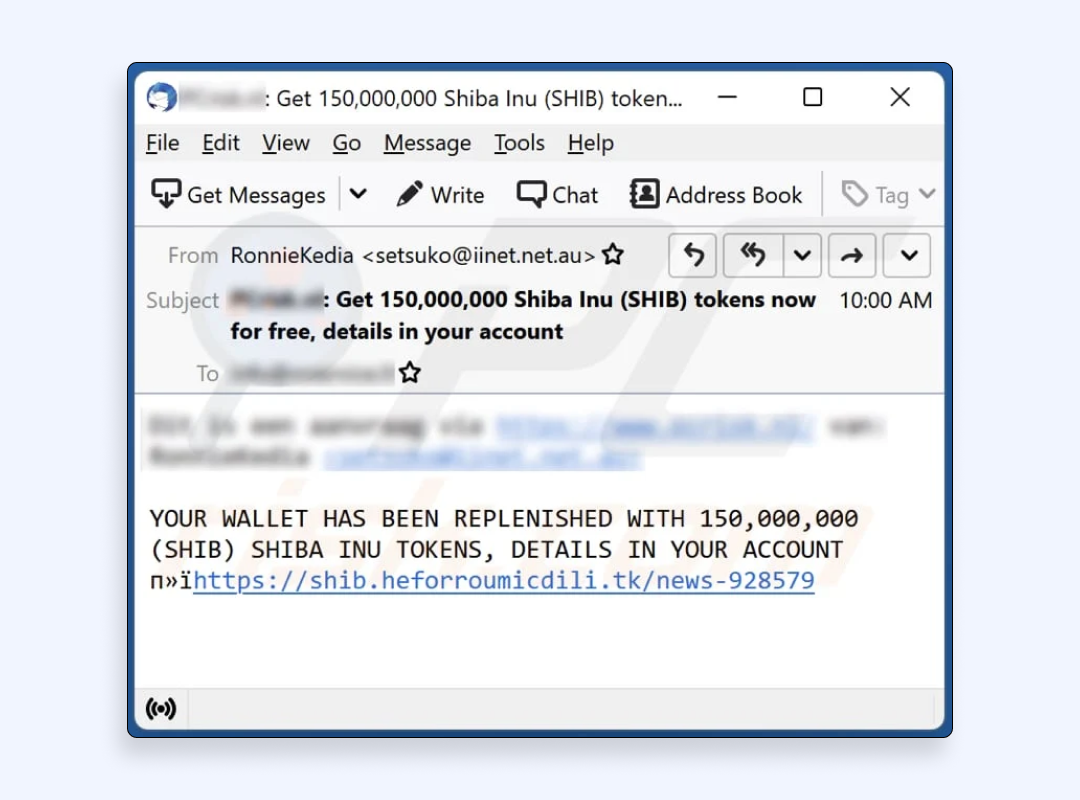
2. Malicious browser extensions
Some browser extensions, posing as helpful crypto tools, contain malicious code that can hijack transactions or steal sensitive information.
Case in point: in December 2023, attackers compromised versions 1.1.5 to 1.1.7 of Ledger’s Connect Kit, injecting malicious JavaScript that could drain users’ wallets when they interacted with affected DApps.
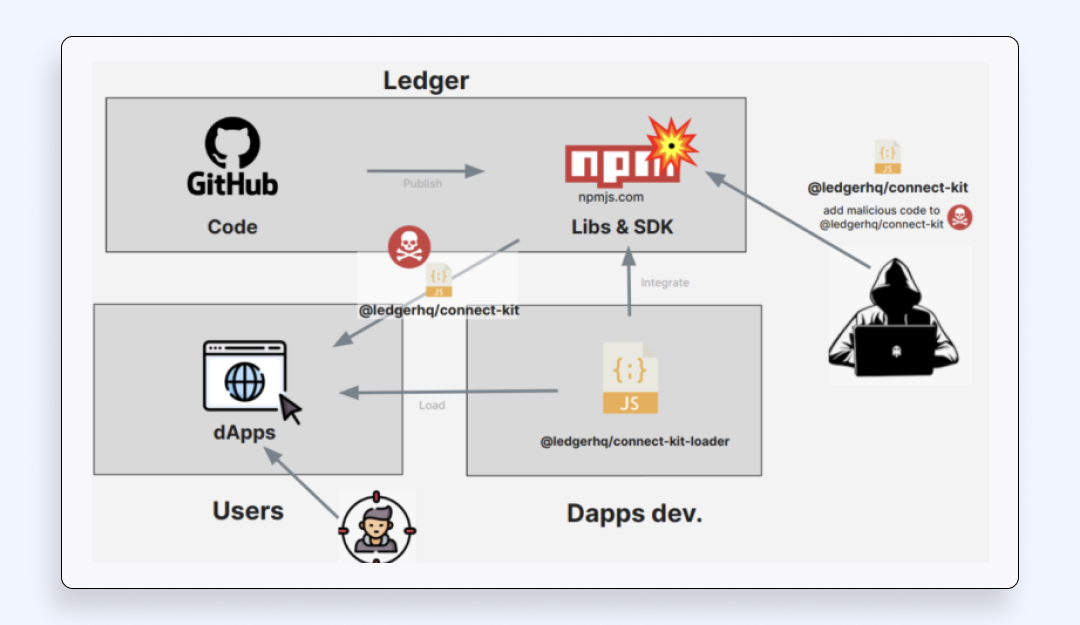
3. AI-driven social engineering scams
Advancements in AI have enabled scammers to create highly convincing fake identities, often used in “pig butchering” scams. These involve building a relationship with the victim over time, eventually persuading them to invest in fraudulent crypto schemes.
In 2024, “pig butchering” scams contributed to a 40% increase in crypto fraud revenue, with losses estimated at $9.9 billion.
4. Hack attacks when using public Wi-Fi
Using public Wi-Fi in cafes or airports is not a good idea, as hackers can set up such hotspots to intercept your data, swap your wallet address mid-transaction, or steal login details. These “man-in-the-middle” attacks are hard to detect and can lead to instant fund loss, and you won’t even realize it.
Having talked about the dangers, let’s cover the ways you can avoid some types of danger or add additional protection layers to safeguard your sensitive financial data.
How you can protect your crypto wallets
Before you go after free crypto, take a minute to secure the wallet where it’s going to land. A vulnerable wallet is an open invitation for scammers.
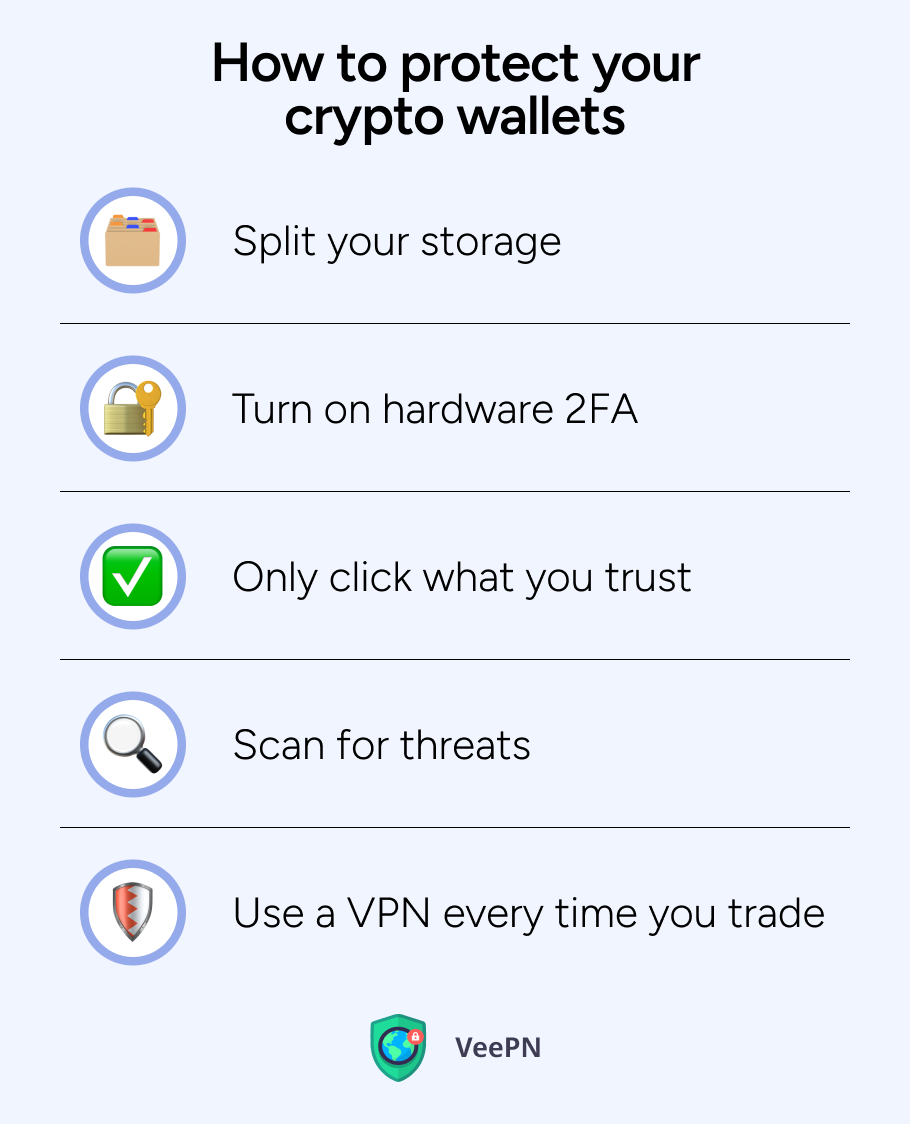
Split your storage
Use one wallet for experimenting with airdrops or new platforms, and another for serious holdings. Keep larger amounts in cold storage, which means offline, like on a hardware wallet, where hackers can’t touch it.
Turn on hardware 2FA
Most major exchanges, like Binance or Coinbase, let you link a physical security key. It’s way stronger than just a password. When you log in, the platform asks you to insert your key and tap it to verify it’s really you. That means even if someone gets your password, they still can’t access your account without that physical key in their hands.
Only click what you trust
Always bookmark the official URL of your exchange or wallet provider. Phishing scams often mimic support chats, like the mentioned Ledger scam that fooled users into handing over their wallet access.
Scan for threats
Before you join airdrops, use faucets or try new crypto platforms, run a malware scan and clean out any sketchy browser extensions. Some extensions might secretly log what you type or tamper with wallet addresses. It puts your crypto rewards at risk before you even receive them.
Use a VPN every time you trade
Use a VPN every time you do crypto trading. With it, you encrypt your connection, hide your IP, and make sure nobody can spy on what you’re doing, especially on unprotected public Wi-Fi networks.
But not all VPNs are the same, because free VPNs often log what you do online and sell your details to advertisers and other third parties. They may also fill your device with ads or malware. Many of them offer weak encryption, which makes you vulnerable to attacks. Ultimately, using a free VPN means you might not be able to access crypto platforms safely, because they offer a small number of servers available.
That’s why consider choosing a trustworthy VPN provider like VeePN, which really protects your data.
How VeePN protects your crypto income
VeePN is a reliable assistant for your crypto earning. While you focus on collecting coins, it quietly locks the doors behind you. Here is what it brings to the table:
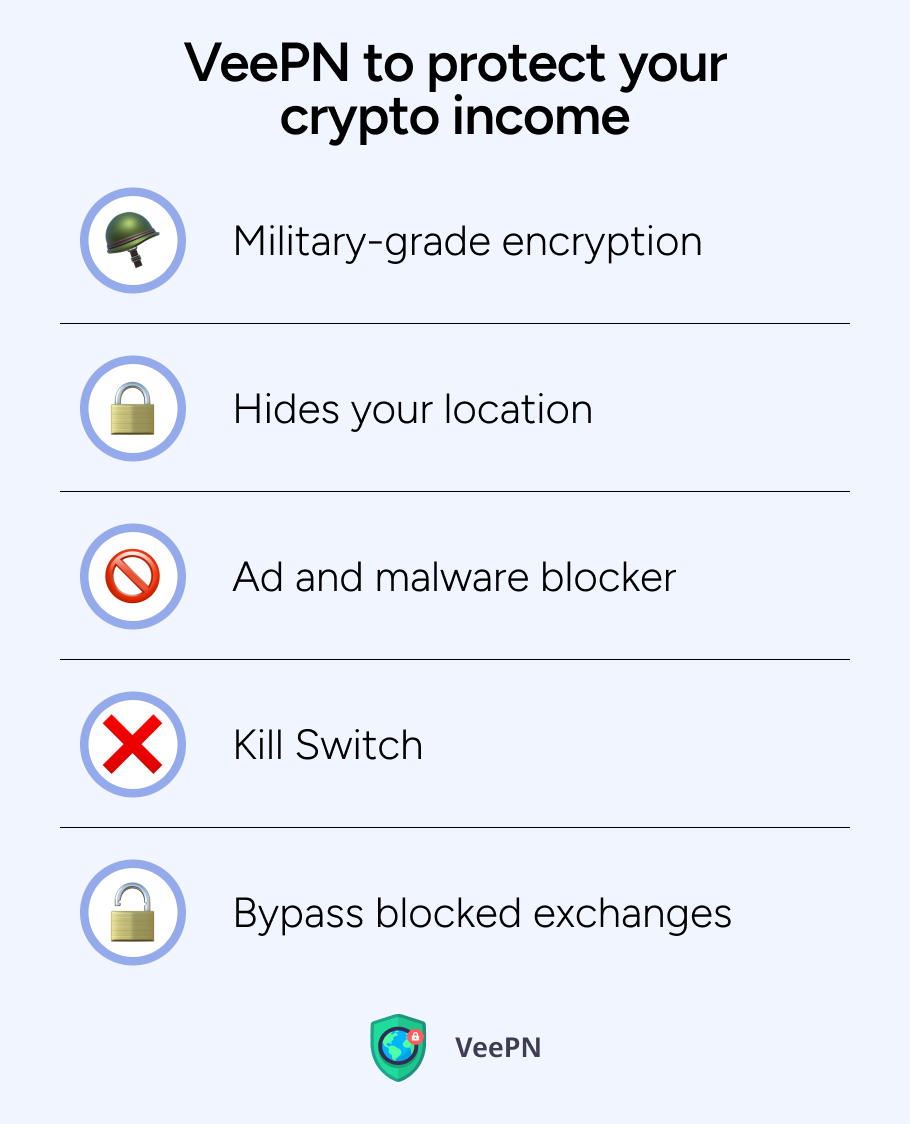
Military-grade encryption
VeePN uses the strongest to date AES-256 encryption standard to scramble your data. So even if you’re using a café Wi-Fi to claim faucet rewards, no one can eavesdrop on your activities and steal your data.
Hides your location
VeePN assigns you a new IP address from one of our 2500+ servers in 60 countries. In this way, phishing sites and trackers can’t target you based on region.
Ad and malware blocker
VeePN’s NetGuard feature filters out malicious content on crypto-earning sites, scam pop-ups, and phishing redirects before they appear. It stops threats at the source and protects your browser and your crypto wallets.
Kill Switch
If your VPN connection unexpectedly glitches or drops, VeePN instantly cuts your Internet connection so that your wallet address doesn’t leak.
Bypass blocked exchanges
Some crypto platforms block users from certain countries like KuCoin or MEXC. VeePN helps you trade safely by routing traffic through platform-friendly regions.
Breach Alert
VeePN scans data breach databases and the dark web for leaked credentials tied to your email or crypto wallets. If your information is spotted in a known breach or on shady marketplaces, you’ll get an instant alert. This gives you the time needed to secure your accounts before hackers strike.
Multi-device protection
You can cover up to 10 devices at once under one VeePN subscription, from your faucet-hunting smartphone to the desktop wallet where you stash your gains.
Try using VeePN without risks to earn crypto for free safely, as we offer a 30-day money-back guarantee.
FAQ
You can get free crypto through
- Airdrops
- Learn-and-earn programs
- Faucet sites
- By referring friends to exchanges.
Some platforms also allow you to earn free Bitcoin simply by playing games or watching videos.
If you’re one of the crypto enthusiasts stacking up rewards, keep in mind that you might need to report it later when dealing with crypto taxes. Read more ways to earn free crypto in this article.
VeePN is freedom
Download VeePN Client for All Platforms
Enjoy a smooth VPN experience anywhere, anytime. No matter the device you have — phone or laptop, tablet or router — VeePN’s next-gen data protection and ultra-fast speeds will cover all of them.
Download for PC Download for Mac IOS and Android App
IOS and Android App
Want secure browsing while reading this?
See the difference for yourself - Try VeePN PRO for 3-days for $1, no risk, no pressure.
Start My $1 TrialThen VeePN PRO 1-year plan






